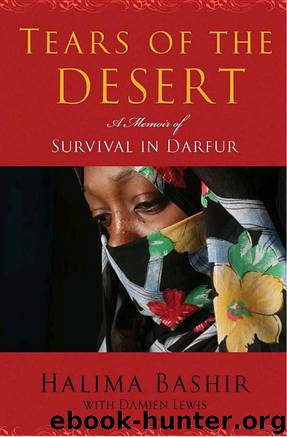Tears of the Desert: A Memoir of Survival in Darfur by Halima Bashir & Damien Lewis

Author:Halima Bashir & Damien Lewis [Bashir, Halima & Lewis, Damien]
Language: eng
Format: epub
Tags: Biography & Autobiography, Nonfiction, Personal Memoirs, Retail
ISBN: 9780345509901
Google: oxZhI-3J82EC
Amazon: B001FA0L6C
Publisher: One World/Ballantine
Published: 2008-09-09T04:00:00+00:00
CHAPTER FOURTEEN
Rumors of War
I knew how valuable my qualifying as a doctor would be for the people of our village. That gave me the strength and fortitude to persevere with my studies, and I did well. There were several further shutdowns of the university, but luckily they largely left the medical faculty alone. Perhaps they realized that they needed doctors in the country, and to send medical students to fight in this futile, murderous war wasn’t very wise.
I became increasingly fascinated by the traditional medicines used by Halima the Fakir, and by Grandma. I had good laboratory facilities at my disposal, and I decided to determine what medicinal value such cures might have. I was particularly interested in the ointment made out of burned pigeon feces, which was used to treat cuts and burns. Then there were the scores of plants, shrubs, bark, and roots that Halima and Grandma took from the forest. Each time I went home I gathered a few more samples.
Some of these village cures had no medicinal value whatsoever. When someone had jaundice the medicine woman would burn their skin with a knife heated over the fire. Six or seven times she would apply the red-hot knife, the smoke and steam sizzling up from the skin. If you had a bad migraine, the medicine woman would use the hot knife on the side of your head, or on your neck if that’s where the pain was. There was every chance that this would make things worse, especially as the burns so often became infected.
There were other ailments that were treated by traditional “cutting”—but invariably the so-called treatment proved more dangerous than the illness itself. If a child had whooping cough their throat would swell into a big goiter. The medicine woman might decide to cut it in an effort to try to “drain” the goiter. But the goiter was in reality a swollen gland, and more often than not the child would die from the bleeding, infections, and trauma.
One lady in our village had given birth to seven daughters in a row. Her husband had decided to take a second wife, as he desperately wanted a son. Then, to the joy of both parents, their eighth child born was a boy. But he soon developed whooping cough, and so the medicine woman had cut the goiter. The bleeding refused to stop and eventually the boy had died. The distraught father had accused the medicine woman of murdering his son, and the mother had never really recovered her peace of mind.
But several of the herbal cures did seem to have merit. Grandma would make a paste out of the taro shrub to heal wounds. When I tested the taro plant I found it to contain cutins—natural chemicals that promote healing. The drying and burning of the plant simply rendered it into a fine powder, so that it could be more easily applied and absorbed into the wound.
I reached my final year at university proud that I had come so close to achieving my father’s dream.
Download
This site does not store any files on its server. We only index and link to content provided by other sites. Please contact the content providers to delete copyright contents if any and email us, we'll remove relevant links or contents immediately.
| Africa | Asia |
| Canadian | Europe |
| Holocaust | Latin America |
| Middle East | United States |
Fanny Burney by Claire Harman(25786)
Empire of the Sikhs by Patwant Singh(22173)
Out of India by Michael Foss(16312)
Leonardo da Vinci by Walter Isaacson(11906)
Small Great Things by Jodi Picoult(6096)
The Six Wives Of Henry VIII (WOMEN IN HISTORY) by Fraser Antonia(4791)
The Wind in My Hair by Masih Alinejad(4425)
The Lonely City by Olivia Laing(4121)
The Crown by Robert Lacey(4106)
A Higher Loyalty: Truth, Lies, and Leadership by James Comey(4034)
The Iron Duke by The Iron Duke(3640)
Millionaire: The Philanderer, Gambler, and Duelist Who Invented Modern Finance by Janet Gleeson(3570)
Sticky Fingers by Joe Hagan(3454)
Alive: The Story of the Andes Survivors by Piers Paul Read(3313)
Papillon (English) by Henri Charrière(3270)
Joan of Arc by Mary Gordon(3260)
Stalin by Stephen Kotkin(3087)
Aleister Crowley: The Biography by Tobias Churton(3021)
Ants Among Elephants by Sujatha Gidla(2925)
